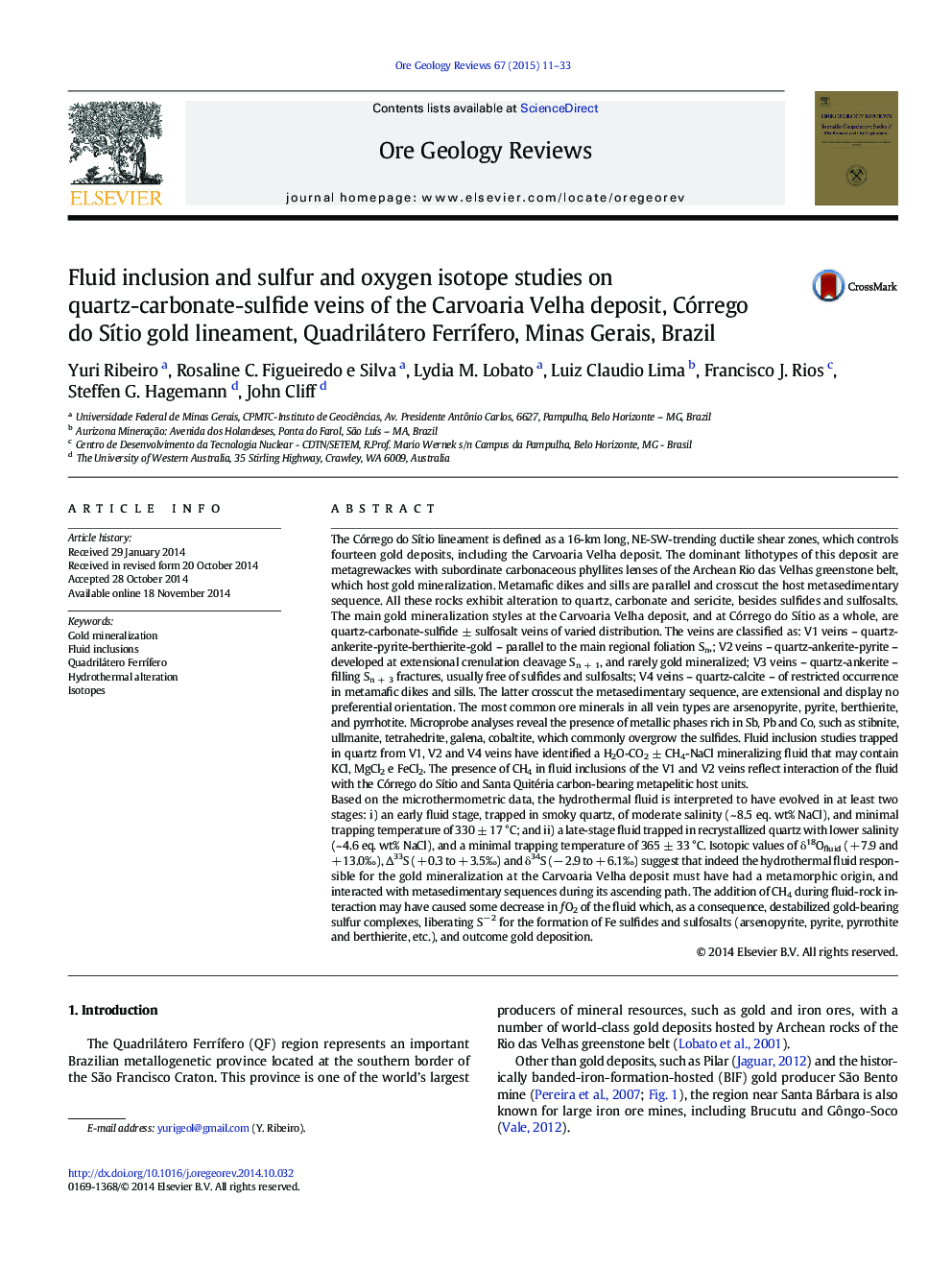| کد مقاله | کد نشریه | سال انتشار | مقاله انگلیسی | نسخه تمام متن |
|---|---|---|---|---|
| 6435878 | 1637237 | 2015 | 23 صفحه PDF | دانلود رایگان |

The Córrego do SÃtio lineament is defined as a 16-km long, NE-SW-trending ductile shear zones, which controls fourteen gold deposits, including the Carvoaria Velha deposit. The dominant lithotypes of this deposit are metagrewackes with subordinate carbonaceous phyllites lenses of the Archean Rio das Velhas greenstone belt, which host gold mineralization. Metamafic dikes and sills are parallel and crosscut the host metasedimentary sequence. All these rocks exhibit alteration to quartz, carbonate and sericite, besides sulfides and sulfosalts. The main gold mineralization styles at the Carvoaria Velha deposit, and at Córrego do SÃtio as a whole, are quartz-carbonate-sulfide ± sulfosalt veins of varied distribution. The veins are classified as: V1 veins - quartz-ankerite-pyrite-berthierite-gold - parallel to the main regional foliation Sn,; V2 veins - quartz-ankerite-pyrite - developed at extensional crenulation cleavage Sn + 1, and rarely gold mineralized; V3 veins - quartz-ankerite - filling Sn + 3 fractures, usually free of sulfides and sulfosalts; V4 veins - quartz-calcite - of restricted occurrence in metamafic dikes and sills. The latter crosscut the metasedimentary sequence, are extensional and display no preferential orientation. The most common ore minerals in all vein types are arsenopyrite, pyrite, berthierite, and pyrrhotite. Microprobe analyses reveal the presence of metallic phases rich in Sb, Pb and Co, such as stibnite, ullmanite, tetrahedrite, galena, cobaltite, which commonly overgrow the sulfides. Fluid inclusion studies trapped in quartz from V1, V2 and V4 veins have identified a H2O-CO2 ± CH4-NaCl mineralizing fluid that may contain KCl, MgCl2 e FeCl2. The presence of CH4 in fluid inclusions of the V1 and V2 veins reflect interaction of the fluid with the Córrego do SÃtio and Santa Quitéria carbon-bearing metapelitic host units.Based on the microthermometric data, the hydrothermal fluid is interpreted to have evolved in at least two stages: i) an early fluid stage, trapped in smoky quartz, of moderate salinity (~ 8.5 eq. wt% NaCl), and minimal trapping temperature of 330 ± 17 °C; and ii) a late-stage fluid trapped in recrystallized quartz with lower salinity (~ 4.6 eq. wt% NaCl), and a minimal trapping temperature of 365 ± 33 °C. Isotopic values of δ18Ofluid (+ 7.9 and + 13.0â°), Î33S (+ 0.3 to + 3.5â°) and δ34S (â 2.9 to + 6.1â°) suggest that indeed the hydrothermal fluid responsible for the gold mineralization at the Carvoaria Velha deposit must have had a metamorphic origin, and interacted with metasedimentary sequences during its ascending path. The addition of CH4 during fluid-rock interaction may have caused some decrease in ÆO2 of the fluid which, as a consequence, destabilized gold-bearing sulfur complexes, liberating Sâ 2 for the formation of Fe sulfides and sulfosalts (arsenopyrite, pyrite, pyrrothite and berthierite, etc.), and outcome gold deposition.
Journal: Ore Geology Reviews - Volume 67, June 2015, Pages 11-33